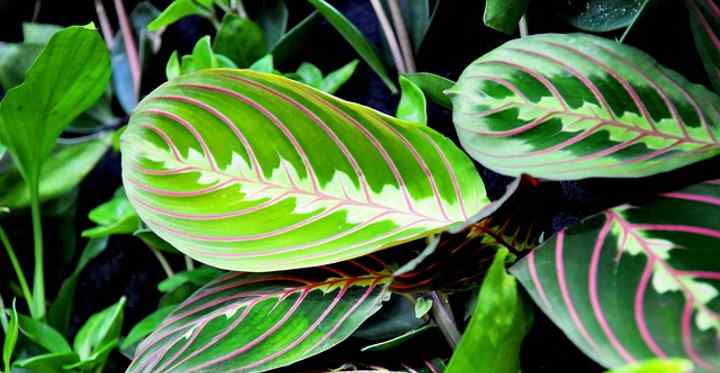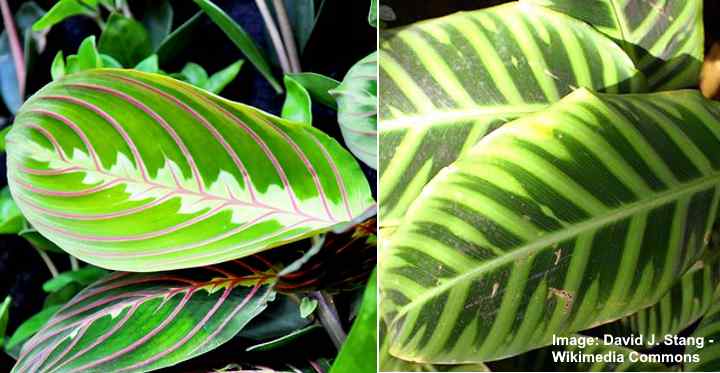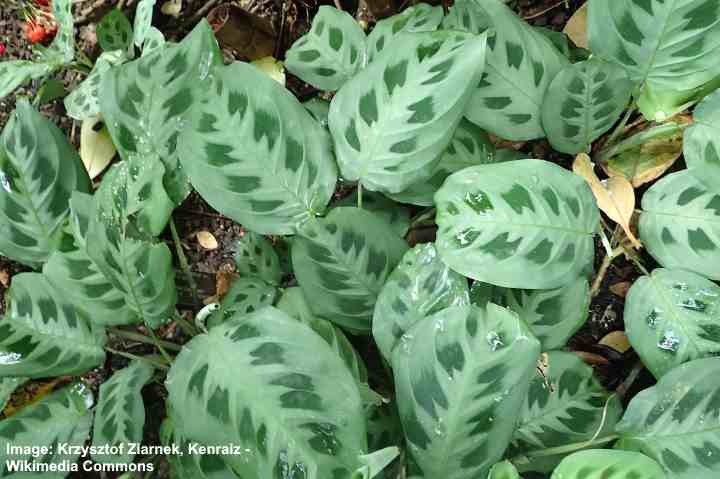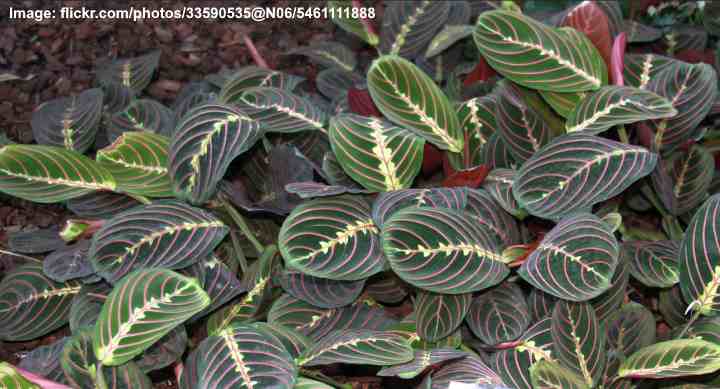Prayer Plant (Maranta Plant): Ultimate Care Guide

Prayer plants (Maranta leuconeura) are beautiful indoor houseplants with fascinating broad green leaves. The leaves can have pink-colored stripes or veins, dark green splotches, or red or white markings. Also called prayer plants, maranta plants are easy to grow indoors with few care requirements.
How to care for prayer plant: Grow your maranta plant in well-draining soil, provide adequate humidity, and bright indirect light. Prayer plants thrive in average household temperatures between 65 and 75°F (18 – 23°C). Feed your maranta leuconeura plant every two weeks in spring and summer to help the plant grow well indoors.
Caring this way for your prayer plant helps to mimic their native environment in tropical rainforests.
In this article, you will find out the best care tips for growing a prayer plant in your home or office. You will also learn about some of the most popular types of marantas you can buy.
What is a Prayer Plant (Maranta leuconeura)?
In the wild, prayer plants are perennial flowering plants that bloom in spring with small, white flowers. As a houseplant, prayer plants rarely flower. It is the stunning beauty of the plant’s foliage that has made this a household favorite. Even in low-light conditions, prayer plants continue to grow well and thrive.
Why are Maranta leuconeura plants commonly called prayer plants? The common name comes from the way the leaves raise and fold in together in the evening or night. This fascinating display resembles putting hands together in a prayer pose.
These easy-to-grow houseplants have roots called rhizomes that look like small potatoes or tubers. A prayer plant can grow up to 12” (30 cm) tall and has evergreen oval leaves with unusual markings.
Prayer plants are excellent to add natural foliage to a shelf, desk, corner of a room, or in a hanging basket.
Prayer Plants: Calathea or Maranta?

Maranta (left) and calathea (right) are similar plants belonging to the same family (Marantaceae) but are different species
Generally, the term prayer plant refers to leafy houseplants in the genus Maranta. Identifying species in the genus Maranta can be confusing because it is related to plants in the genus Calathea, which are also called prayer plants. Both genera are in the family Marantaceae, but they are a different species.
The leaves of Maranta and Calathea plants turn up into a prayer pose at dusk in a process called nyctinasty. All plants in both genera have ornately patterned leaves, and some have colorful striped markings. Some species and cultivars also have leaves with different colored undersides from the top side.
This article deals specifically with how to care for cultivars in the Maranta leuconeura species. Because marantas and calatheas are related, the care tips also apply to both types of plants.
Types of Prayer Plant (Marantas)
There are around 50 prayer plant species and cultivars to choose from. Let’s look at five of the most popular ones.
Rabbit’s Foot Prayer Plant (Maranta leuconeura ‘kerchoveana’)

Also called the green prayer plant, the Rabbit’s Foot payer plant is the classic houseplant that thrives indoors. The leaves of this maranta plant are green-grey with darker green markings on both sides of the central vein. The undersides of the leaves are silvery green. The common names “Rabbit’s Foot” and “Rabbit’s Tracks” come from the markings that look like a rabbit’s footprints.
Red Prayer Plant (Maranta leuconeura ‘erythroneura’)

The red prayer plant has glossy dark-green leaves with pronounced red-colored veins in the leaves. The middle section of the leaf has lighter green markings running up the center. This maranta plant has reddish-purple leaf undersides.
Black Prayer Plant (Maranta leuconeura ‘leuconeura’)

The black prayer plant has large striking dark green oval leaves with thin pink veins extending from the center with lighter green thin patterns running up the center. The underside leaves are reddish-purple.
Kim Prayer Plant (Maranta leuconeura ‘Kim’)
The Kim prayer plant has the classic “rabbit’s foot” patterns of common green prayer plants. This cultivar has dark purple splotches on light green leaves. The plant’s veins are a creamy-white color.
Marisela Prayer Plant (Maranta leuconeura ‘Marisela’)

The Marisela cultivar has striking cream-colored herringbone-like patterns. The beautiful foliage is in various shades of light and dark green. The trailing nature of the Marisela prayer plant means it’s suitable for hanging baskets.
How to Care for a Prayer Plant
Read on to learn about the proper type of soil, fertilizer, and watering requirements for your prayer plant. Find out answers to: Where is the best location for your prayer plant? Are prayer plants toxic to pets? How to repot a prayer plant?
Best Soil for Prayer Plants (Maranta)
Prayer plants need well-draining soil that contains peat moss and some sand to create loamy soil. Adding coarse sand or perlite to the potting mixture helps excess water to drain. Prayer plants also grow well in slightly acidic soil of pH 5.5 – 6.0.
To create the ideal potting medium for prayer plants, combine 1-part garden soil, 1-part perlite, and 1-part peat moss. Then add a pinch of lime dust to help balance the pH levels in the soil.
Another care tip for growing your prayer plant is to add a layer of pebbles to the bottom of the pot. This trick helps to improve airflow and allows water to drain easier. Remember always to use containers that have drainage holes in the bottom.
Best Location for Prayer Plants
The best location for your prayer plant is in a bright, warm place. Anywhere in a room or office that is well-lit, free from drafts, and not beside a radiator is ideal. The most important advice is to keep prayer plants away from direct sunlight.
Usually, a south- or west-facing room is an excellent place to grow your prayer plant. If you want to put your prayer plant on a windowsill, make sure it’s behind a sheer curtain to protect it from the sun’s rays. Getting too much direct light can be a reason why the tips of the leaves turn brown.
One of the best things about caring for prayer plants is that they also grow well in darker, low-light areas. The low light is similar to their native growing environment on the rainforest floor when sunlight can be minimal.
Stems that become long and spindly is one sign that your prayer plant needs more light. So, if you notice that stems are getting leggy, move the prayer plant to a brighter location and prune off the leggy stems.
How to Water Prayer Plants
Water your maranta plant enough so that the soil is always slightly damp. To know when to water your prayer plant, touch the top layer of soil. If it is dry, water it thoroughly. If it seems too moist or soggy, don’t water it until the soil dries out a bit.
Proper care of your prayer plant usually involves keeping the soil moist. The best tip for watering a prayer plant is to water it in the morning with filtered water at room temperature. Watering this way allows the plant to absorb enough moisture during the day and helps prevent root rot. Filtered water also prevents chemicals such as chlorine affecting plant growth.
The frequency you need to water maranta plants depends on several factors. Room temperature, the season, or household heating can all affect how much moisture plants take in. For example, prayer plants need more frequent watering in spring and summer when they grow faster.
The best way to know when to water your maranta houseplant is to check the dampness of the soil.
Prayer Plant Care: Humidity Levels
Prayer plants require high humidity levels similar to their native rainforest environment. Mist prayer plants regularly, use a humidifier or sit them on a pebble tray with water to help increase humidity. When caring for a prayer plant, remember that it needs watering and humidity.
In normal room conditions, spritzing a fine mist on a prayer plant every day is usually enough to hydrate them. Hydrating the leaves is especially necessary in winter when household heating dries out the air. To care properly for your plant in winter, water it less frequently and mist once or twice a day.
Other care tips on increasing humidity for your prayer plant are to place them near other plants or put a small bowl of water near your plant.
Because prayer plants can live for 30 or 40 years or even more, you will need to dust the leaves occasionally. If you take a damp cloth to wipe the leaves, you will not only clean them, but you’ll also hydrate them at the same time.
Dry, brown leaf tips on your prayer plant leaves are one of the signs that humidity levels need increasing. Also, avoid watering the leaves as this can cause leaf rot. However, a light daily misting is necessary to help your plant thrive.
Temperature for Prayer Plant
The ideal temperature to grow a prayer plant indoors is the average room temperature. So, keep the temperature around 65 and 75°F (18 – 23°C). Extreme changes in temperature can affect the leaves and growth.
If the temperature inside drops to below 55°F (12°C), you may notice that the prayer plant’s leaves start to wither and turn brown. If the room temperature rises above 80°F (26°C), the green leaves may show signs of leaf burn. This can often happen if a prayer plant is on a south-facing window in direct sunlight.
As well as keeping the temperature right, you need to ensure that air circulates well. While not placing in direct drafts, the circulating air encourages proper growth and lush foliage.
How to Feed a Prayer Plant (Maranta leuconeura)
Start feeding your prayer plant in early spring. Houseplant fertilizer boosts growth and keeps the leaves shiny and healthy. Usually, feeding every two weeks is enough. The best fertilizer is a balanced solution that is diluted to half-strength. Continue feeding throughout the summer until early fall.
Providing the necessary nutrients for your maranta plants is essential to encourage healthy growth. The balance of nutrients helps to keep the red, white, pink, and green leaf colors vibrant.
When it comes to proper feeding, balance is critical. Not enough feeding can result in weak growth and a generally unhealthy appearance. If you use too much fertilizer, you can end up with brown leaves and damaged roots.
During winter, when the prayer plant becomes dormant, the only care you need to give it is watering and misting.
Pruning a Prayer Plant
Prune your prayer plant by cutting just above leaf nodes using a pair of sterilized garden scissors. Pruning two or three times a year (best times are in fall and spring) helps to encourage bushy growth. Pruning a prayer plant also helps to remove any leggy stems or dead leaves.
New healthy stems will grow from the pruned stems. With regular pruning, you can grow a beautiful prayer plant with a bushy appearance and magnificent healthy leaves.
Although it’s rare for a prayer plant to flower indoors, if it does bloom, you can snip off the flowers. These insignificant blooms can sap essential nutrients from the striking foliage. However, leaving the flowers to bloom won’t cause any lasting damage to the indoor plant.
Prayer Plant Propagation
Propagate your prayer plant in the spring by cutting off healthy stems just below the last node at the base. Remove the first pair of leaves from the bottom. Put in a pot containing potting soil and perlite. Place in a bright location and cover with plastic that has some holes in it.
You can propagate a prayer plant by placing a stem cutting in a glass of water. Wait until the roots are 1” (2.5 cm) long before transferring to a pot. A mixture of soil, peat, and perlite or coarse sand helps create the perfect type of soil for growing a prayer plant.
Another method of prayer plant propagation is by dividing the rhizomes. Carefully remove the plant from the pot and shake off excess soil. Divide the tuber roots into two or three parts and repot.
You can also use any part of a prayer plant that has broken off to propagate it. Just dip the broken end into a rooting hormone mixture to stimulate new growth.
Repotting Your Prayer Plant
Prayer plants are slow-growing plants and don’t require repotting very often. A sign you need to repot your prayer plant is a lack of growth. All you need to do is transfer your plant to a pot 2” (5 cm) wider than its current container. Add some fresh potting mix.
When should you repot a prayer plant? The best care advice is to repot your plant in spring or summer. Repotting at this time prevents cold weather shocking its roots and helps to encourage healthy growth.
Maranta (Prayer Plant) Pests and Diseases
Pests that can affect maranta plants include aphids, spider mites, and mealybugs. Proper care usually helps to keep diseases such as fungal diseases and leafspot to a minimum. Not over-watering your plant and regular misting helps to keep roots healthy and spider mites away.
Brown leaves are usually a sign that the soil is waterlogged, or it’s getting too much direct sunlight. If root rot is a problem, you may have to repot it to help revive a dying prayer plant. Remove the plant from the container and shake the soil from the roots. Prune off any dead or diseased roots. Repot using fresh soil and water thoroughly. Only water your plant when the soil becomes slightly dry.
Mealybugs, aphids, and spider mites stress out plants and affect growth. Try using neem oil or an organic pesticide to get rid of bugs that are affecting your plants.
Are Prayer Plants Toxic?
No, prayer plants are not poisonous to humans, cats, or dogs.
Related articles:
